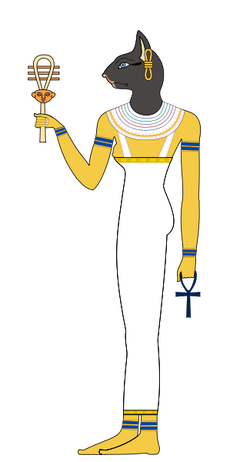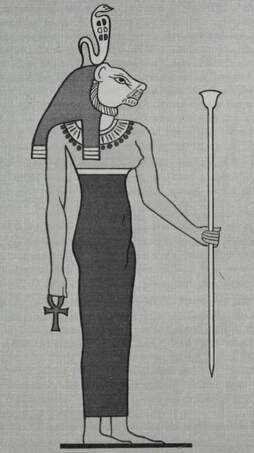Per-Bast(et)
𓎯𓏏𓏏𓁐MK-NK 𓅡𓋴𓎯𓏏𓏏OK 𓋴𓅡𓎯𓏏𓏏 𓎯𓏏𓏏 𓎯𓏏𓆇𓁐 𓃀𓋴𓎯𓏏𓏏Budge 𓃀𓅡Budge 𓎯𓏏𓆇𓏏𓆇𓆗Budge 𓃀𓅡𓊨𓏏𓏤𓆗Budge 𓎯𓏏𓆇Budge 𓎯𓏏𓏏𓆇𓁐Budge 𓎯𓋴𓏏𓆇𓁐Budge 𓃀𓅡𓋴𓏏𓏏𓎯𓁐 Budge
MDC: bAst, bAstt
Gardiner: bꜢst , bꜣstt
Budge: Bast, Bastt
Alt Egyptian: BꜢstjt
Transliteration: Bast, Bastet
Late Egyptian: ꜣbst
Demotic: Bꜣst
Coptic: Bastā/ ⲃⲁⲥⲧⲉ, Oubasti/ⲟⲩⲃⲁⲥϯ (F?), oubaste/ⲟⲩⲃⲁⲥⲧⲉ [/ʔuːˈβastə/] (S), oubasti/ⲟⲩⲃⲁⲥϯ, basti/ⲃⲁⲥϯ (B),
basti/ⲃⲁⲥϯ < From Per-Basti/ⲡⲟⲩⲃⲁⲥϯ (B), bastʰi/ⲃⲁⲥⲑⲓ
Phoenician: Abst/𐤀𐤁𐤎𐤕 , ’bst/ 𐤁𐤎𐤕
Akkadian: Bišti 𒄫𒋾 (biš-ti /ubešti, bīšti/)→ 𒌑𒁀𒋛𒋾 (ú-ba-si-ti /ubešti/)
Cuneiform : biš-ti
Aramaic: Abst/ אבסת, Abst/ Ꜣbst/ 𐡀𐡁𐡎𐡕
Hebrew: Best, Beseth/ ב֦סֶת , Bast/ באסת , Bstt/ בסתת , Pibeset "House of Bastet" (Vortonsilbe, Ezek 30:17)
Ancient Greek: ούβαστις (oúbastis) in Βούβαστις (Boúbastis)
Koinē Greek : Ailuros/αἴλουρος 'cat'
Greek: Bastis/ βαστις, Bast/ Βαστ, Boubastis/ Βούβαστις, Oubastis /Ουβάστις, Oumpásti/Básti/ Ουμπάστι; (modern) Mpastét/Bastét/ Μπαστέτ (used by Egyptology), Mpast/Baset/Μπαστ, Mpástet/Bástet/ Μπάστετ, Mpasét/Basset/ Μπασέτ, Aílouros/ Αἴλουρος (cat)
Greek IPA: bǒː.bas.tis/ > /ˈβu.βas.tis/ > /ˈvu.vas.tis/
Latin: Bubastis
Arabic: Bāstyt, Basti باستيت
English: Bast, Bastet
Kemetic: Bast
Alt: BꜢstjt , B(u)bastis
IPA: Bʔst, Bʔatet
Traditional Pronounced: Bastet , Bast
Pronounced: Obast, Ubasti (More accurate), Basti (1st Millennium)
Alt Pronunciation: (Some claim, from Coptic and Aramaic translation) Ubasti, Obast, Wubesti, b(u)Ꜣést˘t (from Coptic ubesti) (Osing); Bišti
IPA reconstruction : buˈʀistʰatʰ (possibly orginal); buʔístit or buʔístiat (J.P.A)
buˈʀistit (OE)
buˈʀistiʔ (ME)
ˈbistʰə(NK)
ʔuˈβestə → bu’ísti:t [buʔísti:t or buʔístiat (Osing) béstʰe, ʔuˈβestə (LE) ,
uˈβastʰə (Greco-Romen)
(Peust) → ubísti (Later) ;
Meaning: She of the perfume or ointment jar (𓅡𓋴 bAs ointment jar), She of fire (𓃀𓋴𓊮 bs fire)
Ref: Faulkner, Hoch, Westendorf, Takács, Gábor , Jürgen, Velde, Kanaanäische und Aramäische Inschriften, Corpus Inscriptionum Semiticarum
Gardiner: bꜢst , bꜣstt
Budge: Bast, Bastt
Alt Egyptian: BꜢstjt
Transliteration: Bast, Bastet
Late Egyptian: ꜣbst
Demotic: Bꜣst
Coptic: Bastā/ ⲃⲁⲥⲧⲉ, Oubasti/ⲟⲩⲃⲁⲥϯ (F?), oubaste/ⲟⲩⲃⲁⲥⲧⲉ [/ʔuːˈβastə/] (S), oubasti/ⲟⲩⲃⲁⲥϯ, basti/ⲃⲁⲥϯ (B),
basti/ⲃⲁⲥϯ < From Per-Basti/ⲡⲟⲩⲃⲁⲥϯ (B), bastʰi/ⲃⲁⲥⲑⲓ
Phoenician: Abst/𐤀𐤁𐤎𐤕 , ’bst/ 𐤁𐤎𐤕
Akkadian: Bišti 𒄫𒋾 (biš-ti /ubešti, bīšti/)→ 𒌑𒁀𒋛𒋾 (ú-ba-si-ti /ubešti/)
Cuneiform : biš-ti
Aramaic: Abst/ אבסת, Abst/ Ꜣbst/ 𐡀𐡁𐡎𐡕
Hebrew: Best, Beseth/ ב֦סֶת , Bast/ באסת , Bstt/ בסתת , Pibeset "House of Bastet" (Vortonsilbe, Ezek 30:17)
Ancient Greek: ούβαστις (oúbastis) in Βούβαστις (Boúbastis)
Koinē Greek : Ailuros/αἴλουρος 'cat'
Greek: Bastis/ βαστις, Bast/ Βαστ, Boubastis/ Βούβαστις, Oubastis /Ουβάστις, Oumpásti/Básti/ Ουμπάστι; (modern) Mpastét/Bastét/ Μπαστέτ (used by Egyptology), Mpast/Baset/Μπαστ, Mpástet/Bástet/ Μπάστετ, Mpasét/Basset/ Μπασέτ, Aílouros/ Αἴλουρος (cat)
Greek IPA: bǒː.bas.tis/ > /ˈβu.βas.tis/ > /ˈvu.vas.tis/
Latin: Bubastis
Arabic: Bāstyt, Basti باستيت
English: Bast, Bastet
Kemetic: Bast
Alt: BꜢstjt , B(u)bastis
IPA: Bʔst, Bʔatet
Traditional Pronounced: Bastet , Bast
Pronounced: Obast, Ubasti (More accurate), Basti (1st Millennium)
Alt Pronunciation: (Some claim, from Coptic and Aramaic translation) Ubasti, Obast, Wubesti, b(u)Ꜣést˘t (from Coptic ubesti) (Osing); Bišti
IPA reconstruction : buˈʀistʰatʰ (possibly orginal); buʔístit or buʔístiat (J.P.A)
buˈʀistit (OE)
buˈʀistiʔ (ME)
ˈbistʰə(NK)
ʔuˈβestə → bu’ísti:t [buʔísti:t or buʔístiat (Osing) béstʰe, ʔuˈβestə (LE) ,
uˈβastʰə (Greco-Romen)
(Peust) → ubísti (Later) ;
Meaning: She of the perfume or ointment jar (𓅡𓋴 bAs ointment jar), She of fire (𓃀𓋴𓊮 bs fire)
Ref: Faulkner, Hoch, Westendorf, Takács, Gábor , Jürgen, Velde, Kanaanäische und Aramäische Inschriften, Corpus Inscriptionum Semiticarum
Home: Amenti, west of the Nile
Temple: 18th Nome LE Per-Bast/ pr-bAstt/ Pîbeset, Pibeseth/ تل بسطاء, פִּיב֦סֶת / Tel Basta, Bubastis /Βούβαστις capital of nome Ȧm-khent
Cult: Bubastis,/per-Bast/ pi-bast /poubasti /ⲡⲟⲩⲃⲁⲥϯ
𓉐𓏤𓃀𓅡𓊨𓏏𓊖 , 𓉐𓏤𓎯𓏏𓆇𓊖
Nome:
11th Nome of Lower Egypt: Taremu (City of fish) Egyptian and Coptic, Leontoplis Λεόντων πόλις (city of Lions) Greek, el-Muqdam (mound of the city) Arabic, Leontos Latin, 18th nome Lower Egypt : Per-Bast at Am-Khent
Consort
Ra
Ptah (18th Nome LE Am-Khent, Per-Bast/ Boubastis, Memphis)
Bas (Greco-Romen period)
Tem/Atum (13th nome LE Heka-At, Iunu/Heliopolis)
Anpu ?
Atum (Bubastis)
Children
mAi-HsA/ Ma'ahes (with Tem/Atum at 13th nome LE Heka-At, Iunu/Heliopolis)
Khonsu
Nefertem (with Ptah) (Memphis)
Anpu/Anubis? (With Rā)
Horhekenu (Bubastis)
Father
Ra
Nefertem ?
Mother
Siblings
Priest names
imn-a (priestess of Bast)
Followers
Bubasteion
Features
Early on she was a lioness later she became a black female cat holding a sistrum..
Symbols
Perfume bottles
Lion
cat
sistrum
Wadje Eye 𓂀
spdt/ Sothis star
Roles
Eye of Ra, warfare in Lower Egypt, patron of cats, protection, joy, dance, music, fertility, perfume, protector of pregnant women, and love. There is some theory that Bastet is indeed Sekhmet but in her more gentle and loving form because they both share the same characteristic even is pared with the same gods as consorts, and often they are both referred to as the the Eye or Ra. Cats were raised in her honor and used to mummify at Bubastis. When a cat dies in a house the house keepers eyebrows would be shaved off and the dead cat taken to the Nome of Bubastis for embalming to be buried in a scared burial chamber. The killing of cats out side sacrifice and mummification out side of Bubastis was strictly prohibited and punishable by death.
Connection to other gods
Sekhmet
Hut-Horut/ Hathor (old Kingdom)
Rāt
Tem (female counter part)
Artemis Ἄρτεμις (Greek)
Celebrations
Bubastis celebration of Bastet 'Feast of drunkenness' Bubasteia was celebrated by intoxication, music, debauchery often children would be born with out fathers after this day.
Offering items
Perfume bottles
Sistrum (can also play it for her)
Catnip
Fish (but be careful not to leave it for long)
Calcite
Alabaster
Other names
pasht- divinity
Temet -- (mother of mAi-HsA /Maahes)
aHA.t-- she who is a fighter (demoness) ref. Gnirs 2009: 131
Epitaphs
aAt-pHty=She with great Strength
irt-ra=Eye of Ra
irt-en-ra=Eye of Ra
Hnwt-Taw-n-anx=The Lady of the Breath of Life
Hnwt-THn=Lady of Splendor
nbt-anx=Lady of Life
nbt-anx-tAwy=Lady of Memphis
nbt-Awt-ib=The Lady of Pleasure
nbt-hkrw=The Lady of Jewelry
nbt-hnw=The Lady of Jubilation
nbt-iAbti=Lady of the East
nbt-iwnt=Lady of Dendera
nbt-nrw=The Lady of Terror
nbt pr bAst=Lady of Bubastis
nbt-pt=Lady of Heaven
nbt-snD=The Lady of Dread
nbt-Sat=The Lady of Slaughter
nbt-tAwy=Lady of the two Lands
nfrt-Hr=beautiful of face
nTrt aA=great goddess
qmAt-stwt=She who creates the rays
sAw= guardian, protector
tpyt-wrt=The Great She
wbnt-m-Axt=Who rises in the Horizon
wrt-m-bAst=The Great in Bubastis
xsrt-kkw=Who drives out darkness
Xwt-it.s-Hry-ib-tA-S=Who protects her Father, who is in Fayum
ⲟⲩⲃⲁⲥϯ ⲧⲉ ⲟⲩⲛⲧⲱⲣⲓ ϧⲉⲛ ⲡϫⲓⲛϣⲉⲙϣⲓ `ⲛⲣⲉⲙⲛⲭⲏⲙⲓ. ϧⲉⲛ ⲡⲓϯⲙⲓ ⲱⲛ ⲟⲩⲃⲁⲥϯ ⲧⲉ ϯϣⲉⲣⲓ `ⲛⲁⲑⲱⲙ.
Bast the great goddess....
ref. https://incubator.wikimedia.org
#bAst, #bAstt , #bꜢst , #Bast, #Bastet
ref. https://docs.google.com/document/d/1_5DinptOtKn5ITkjXuEJzH8y_hIORrXHAJyjD4umBNk/edit#, https://en.wikiversity.org/wiki/User:Danielito_el_traviesito/sandbox



